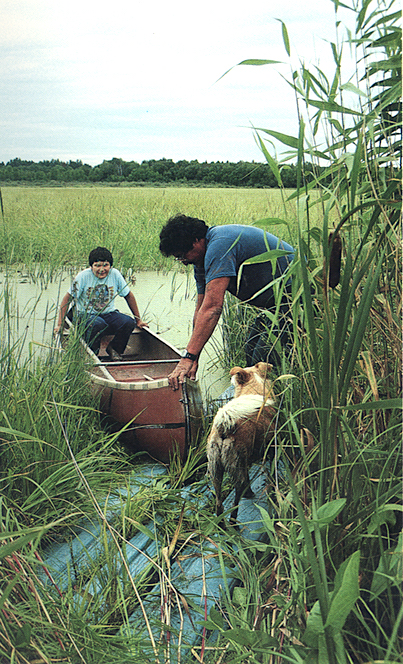Wild Rice & Sulfate Overview
Why is protecting wild rice (Manoomin) important to Minnesota?
- Natural wild rice has enormous ecological value — it protects water quality, reduces harmful algae blooms, and provides habitat for fish, mammals, and wildfowl.
- Manoomin has great cultural importance for Ojibwe/Chippewa people, and it is protected by treaties.
- Wild rice is Minnesota’s state grain.
- Although wild rice has been lost to industrial development and sulfate pollution, Minnesota still has more wild rice than any other state.

Wild rice in bark bowl. Photo by Jim Northrup.
- Wild rice is the equivalent of the “canary in the coal mine” because it is an indicator of water quality. Impaired wild rice is the result of increased sulfate pollution in surface waters, which also increases methylmercury contamination of fish in Minnesota. Methylmercury is a neurotoxin, especially affecting brain development in infants, children, and the unborn fetus.
What is Minnesota’s wild rice sulfate standard?
In 1973, the wild rice sulfate standard was adopted by the Minnesota Pollution Control Agency (MPCA) and approved by the U.S. Environmental Protection Agency (EPA) under the federal Clean Water Act.
The Fond du Lac and Grand Portage Bands of Lake Superior Chippewa also limit sulfate to 10 parts per million (ppm or mg/L) to protect wild rice waters. The bands have authority to set water quality standards on their reservations under The Clean Water Act.
Why have corporate special interests sought its repeal?

Since then, industry lobbyists, consultants, and politicians have sought to eliminate or weaken Minnesota’s wild rice sulfate standard. They have also sought to limit the number of wild rice lakes and streams that can be protected from sulfate pollution.
Most of the sulfate pollution now affecting wild rice waters is discharged by a small number of coal-fired power plants, ethanol plants, taconite mine pits, processing facilities, tailings basin pits, and waste rockpiles. Toxic discharge from the proposed PolyMet copper-nickel sulfide mine would greatly increase the levels of sulfate in wild rice waters, requiring active treatment of pollution for hundreds of years — that is why PolyMet permitting and financial assurance requirements are so important to protect Minnesota wild rice, water quality, and taxpayers.
WaterLegacy has worked in partnership with tribes since 2009 to preserve Minnesota’s wild rice sulfate standard and protect wild rice.
Litigation to Preserve Wild Rice Sulfate Standard
Opposing Legislation to Weaken Wild Rice Protection
Rulemaking to Preserve Wild Rice Sulfate Standard
Scientific Effects of Sulfate Pollution on Wild Rice & Mercury
Enforcement of the Wild Rice Sulfate Standard
- Opposing MPCA weak taconite mining permits that fail to require compliance with the wild rice sulfate standard.
- Advocating to MPCA and EPA that wild rice waters polluted by sulfate discharge be listed as “impaired waters” so that they will be studied and restored.
- Petitioning EPA to remove MPCA’s Clean Water Act authority due to MPCA’s failure to enforce the wild rice sulfate standard and other pollution limits.
Wild Rice Sulfate Standard Timeline
1973
Wild rice sulfate standard adopted by MPCA and approved by EPA under the Clean Water Act.
2010
EPA says MPCA must enforce wild rice sulfate standard.
In December, Minnesota Chamber of Commerce, on behalf of PolyMet and taconite mining companies, sues MPCA to block enforcement of the standard. WaterLegacy intervenes to defend the standard.
2011
Minnesota Legislature passes law starting a process to support repeal or weakening of wild rice sulfate standard through rulemaking.
2012
District Court and Minnesota Court of Appeals rule against Chamber of Commerce (and for WaterLegacy). Wild rice sulfate standard is preserved.
2014
MPCA “pulls the plug” on recommendation to support existing wild rice sulfate standard. MPCA proposes to replace standard with a less protective rule.
2015
Minnesota Legislature passes law preventing enforcement of the wild rice sulfate standard until rulemaking (to amend or repeal standard) is completed.
2016
Minnesota Legislature passes a law preventing MPCA from enforcing terms of a permit (Keetac Mine) containing sulfate limits.
2017
MPCA proposes rule to repeal weaken wild rice sulfate standard and adopt a weaker rule.
2018
In May, MPCA withdraws its proposed rule that would repeal the standard. Wild rice sulfate standard is preserved.
Minnesota Legislature twice passes, and Governor Mark Dayton twice vetoes bills that would repeal the standard.
2019
WaterLegacy and Fond du Lac Band advocate to require compliance with wild rice sulfate standard in appeal of U.S. Steel Minntac tailings basin permit.
WaterLegacy Commentaries
Star Tribune, Dec. 2015 | Counterpoint: “Yes, it’s time — to uphold, not raise, sulfate limits”

Star Tribune, Feb. 2015 | Counterpoint: “The science is clear: Protect our wild rice”
The Earth is not flat, there is no tooth fairy and sulfate limits are required to protect natural stands of wild rice.
